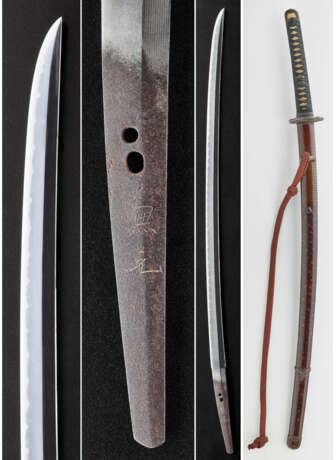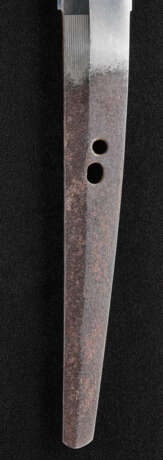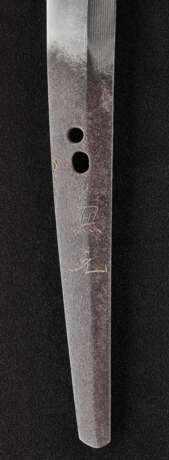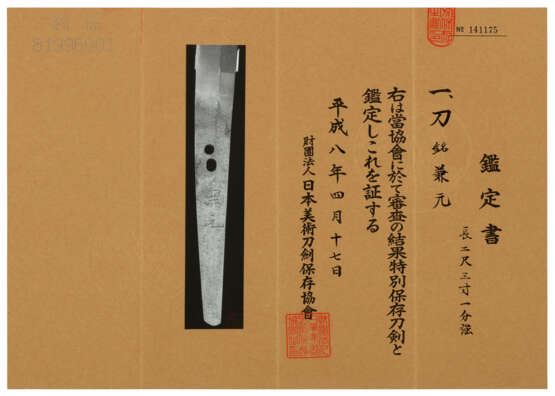ID 813527
Lot 104 | A MINO KATANA
Estimate value
$ 12 000 – 18 000
LATE MUROMACHI PERIOD (16TH CENTURY), SIGNED KANEMOTO
Configuration [sugata]: shobu-zukuri, iori-mune, shallow curvature
Forging pattern [kitae]: clear bright itame mixed with mokume
Tempering pattern [hamon]: gunome with togari-ba in sanbon-sugi form of nioi with ko-nie, some kin-suji and sunagashi
Tip [boshi]: midare-komi with Jizo-type return
Tang [nakago]: slender and tapering, unshortened (ubu); file marks, takanoha; end (nakagojiri): rounded (kurijiri); holes (mekugi-ana): two
Length from tip to beginning of tang [nagasa]: 70.3cm.; curvature 1.3 cm.; width at start of tempered edge 3cm.
Collar [habaki]: single gilt-copper, Shonai-habaki
In shirasaya (wood storage scabbard)
Mounting [koshirae]: handachi koshirae scabbard partially ribbed-form, designed with oil spot pattern on a reddish brown ground, kaeri-tsuno unusually designed in Satsuma style, kabuto-gane, fuchi, seme-kanamono, ishizuki-kanamono copper fittings of ishimeji, iron mokko-shaped tsuba with twisted silver fukurin, signed Kaneshige, tsuba and ishizuki-kanamono with mokko crests, shakudo menuki of shishi, details in gilt, 102.5cm.
Accompanied by Tokubetsu hozon token (Sword especially worthy of preserving) certificate no. 141175, 17 April Heisei 8-nen (1996) issued by the Nihon Bijutsu Token Hozon Kyokai (Society for the Preservation of the Japanese Art Sword)
Provenance
Kaisendo Museum, Yamagata, Japan
| Historical era: | Muromachi period |
|---|---|
| Place of origin: | Eastern Asia, Japan |
| Category: | Swords |
| Historical era: | Muromachi period |
|---|---|
| Place of origin: | Eastern Asia, Japan |
| Category: | Swords |
| Address of auction |
CHRISTIE'S 20 Rockefeller Plaza 10020 New York USA | ||||||||||||||
|---|---|---|---|---|---|---|---|---|---|---|---|---|---|---|---|
| Preview |
| ||||||||||||||
| Phone | +1 212 636 2000 | ||||||||||||||
| Fax | +1 212 636 4930 | ||||||||||||||
| Conditions of purchase | Conditions of purchase | ||||||||||||||
| Shipping |
Postal service Courier service pickup by yourself | ||||||||||||||
| Payment methods |
Wire Transfer | ||||||||||||||
| Business hours | Business hours
|












